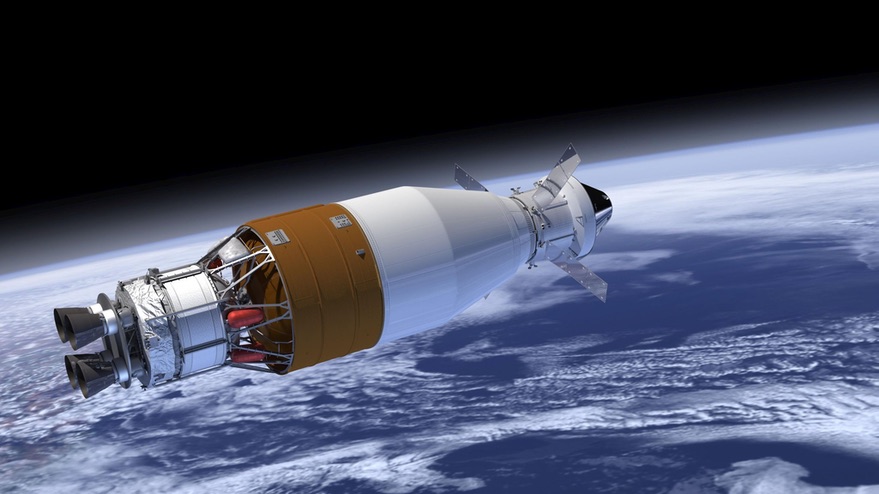WASHINGTON — An upgraded upper stage for the Space Launch System rocket has passed a major review, allowing its prime contractor, Boeing, to start producing hardware.
Boeing announced Dec. 21 that the Exploration Upper Stage (EUS) of the SLS completed a critical design review with NASA. That review confirmed the design of the EUS, allowing Boeing to proceed with development of the stage, including hardware fabrication.
The EUS will be used on the Block 1B variant of SLS, replacing the Interim Cryogenic Propulsion Stage (ICPS) used on the initial Block 1 version of the SLS and based on the Delta 4 upper stage. The EUS will have larger tanks and use four Aerojet Rocketdyne RL10 engines.
The Block 1B will offer increased performance over the Block 1. While the Block 1 can place 27 metric tons onto a translunar injection trajectory, the SLS Block 1B will increase that performance to 38 tons. That will enable SLS Block 1B missions launching Orion spacecraft to carry additional “co-manifested” payloads, such as components for the lunar Gateway.
“EUS was designed for crewed flights from the beginning, and the additional lift capability that comes with the EUS requires fewer flights to enable a sustained human presence in deep space sooner and more safely,” said Steve Snell, EUS program manager at Boeing, in a statement.
The Block 1B version of SLS won’t fly until the mid-2020s, though. The first three SLS missions will be of the Block 1 variant and use the ICPS. This would push out the SLS Block 1B debut beyond 2024, depending on any changes in the schedule of Artemis missions and the potential use of the SLS to launch Europa Clipper.
Without a near-term need for the EUS, NASA sought to slow down its development. Its fiscal year 2021 budget request proposed deferring final design work on the SLS Block 1B. “While the SLS Block 1B configuration with the Exploration Upper Stage (EUS) remains an important future capability, the significant performance and cost challenges faced by NASA’s prime contractor, Boeing, in finalizing the Block 1 core stage, requires that NASA and its contractors concentrate in the near term on the successful completion of the Block 1 SLS and reliably manufacturing flight systems,” the budget proposal stated.
However, Congress has continued to provide funding for EUS. The fiscal year 2021 omnibus spending bill, passed by Congress Dec. 21, directed NASA to spend at least $400 million on Block 1B development, “including the Exploration Upper Stage and associated systems including related facilitization, to support an SLS Block 1B mission available to launch in 2025 in addition to the planned Block 1 missions for Artemis 1 through Artemis 3.”
A NASA authorization bill approved by unanimous consent in the Senate Dec. 18 went even further, directing NASA to continue “development of the Exploration Upper Stage for the Space Launch System with a scheduled availability sufficient for use on the third launch of the Space Launch System.” The bill won’t be taken up by the House in this Congress, but its backers in the Senate see it as a starting point for a new NASA authorization bill next year.
Meanwhile, testing of the core stage for the first SLS mission continues at the Stennis Space Center. NASA said it performed a wet dress rehearsal of the SLS core stage there Dec. 20, loading it with liquid hydrogen and liquid oxygen propellants. This is the penultimate test of the overall Green Run test campaign, with the final test a full-duration static-fire test of the stage’s four RS-25 engines.
NASA halted an earlier attempt at the wet dress rehearsal Dec. 7 when liquid oxygen flowing into the core stage was at slightly higher temperatures than required. NASA said they would make changes to test procedures, rather than to the stage itself, to correct the problem.
“First looks at the data indicate the stage performed well during the propellant loading and replenish process,” NASA said, but noted that the practice countdown, which was to stop 33 seconds before ignition, instead halted a “few minutes” short of that. “The team is evaluating data to pinpoint the exact cause of the early shutdown,” NASA said in a brief statement, noting the issue did not appear to be with the core stage itself.
